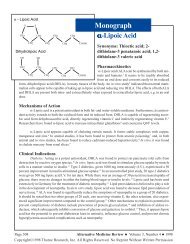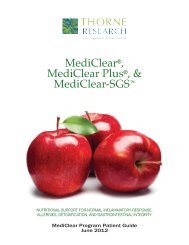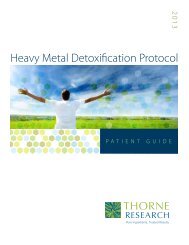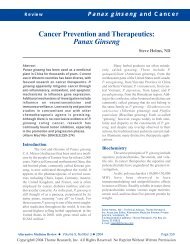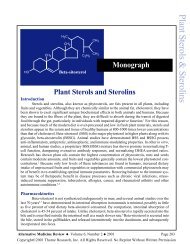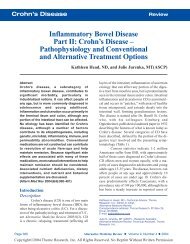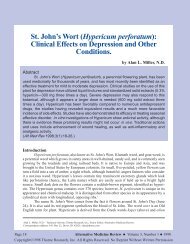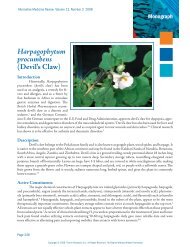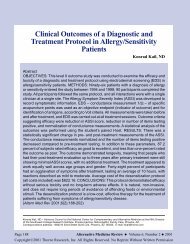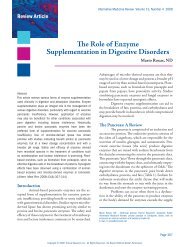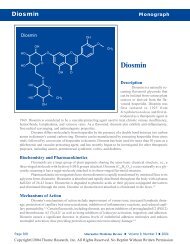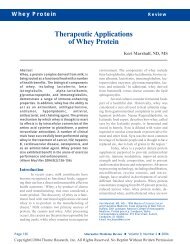Sulforaphane/Sulforaphane glucosinolate - Thorne Research
Sulforaphane/Sulforaphane glucosinolate - Thorne Research
Sulforaphane/Sulforaphane glucosinolate - Thorne Research
Create successful ePaper yourself
Turn your PDF publications into a flip-book with our unique Google optimized e-Paper software.
eadily measurable in human breast tissue. Both detoxification enzyme gene transcripts NADH quinone<br />
reductase (NQ01) and heme oxygenase-1(HO-1) were measureable in the excised breast tissue,<br />
indicating cancer blocking activity after sulforaphane consumption. These findings provide a strong<br />
rationale for evaluating the protective effects of a broccoli sprout preparation in clinical trials of women<br />
at risk for breast cancer.<br />
Dietary sulforaphane-rich broccoli sprouts reduce colonization and attenuate gastritis in Helicobacter<br />
pylori-infected mice and humans.<br />
Yanaka A, Fahey JW, Fukumoto A, et al. Cancer Prev Res 2009;2:353-360.<br />
The isothiocyanate sulforaphane is powerfully bactericidal against Helicobacter pylori infections, which<br />
are strongly associated with the worldwide pandemic of gastric cancer. Forty-eight H. pylori-infected<br />
patients were randomly assigned to feeding of broccoli sprouts (70 grams daily; containing 420<br />
micromol of sulforaphane precursor) for eight weeks or to consumption of an equal weight of alfalfa<br />
sprouts (not containing sulforaphane) as placebo. Intervention with broccoli sprouts, but not with<br />
placebo, decreased the levels of breath test urease as well as H. pylori stool antigen and serum<br />
pepsinogens I and II (biomarkers of gastric inflammation). Daily intake of sulforaphane-rich broccoli<br />
sprouts for two months reduces H. pylori colonization and improves the sequelae of infection in<br />
humans.<br />
Cruciferae interact with the UGT1A1*28 polymorphism to determine serum bilirubin levels in humans.<br />
Peterson S, Bigler J, Horner NK, et al. J Nutr 2005;135:1051-1055.<br />
Gilbert’s syndrome is characterized by genetic polymorphisms in the UDP-glucuronosyltransferase (UGT)<br />
enzymes, the primary one being UGT1A1*28, which is involved in bilirubin glucuronidation. UGT<br />
polymorphisms can manifest as benign unconjugated hyperbilirubinemia associated with reduced<br />
hepatic conjugation, and may increase cancer risk in this population. In an observational study of 191<br />
nonsmoking volunteers (ages 19-40), consuming 0-4 servings of cruciferous vegetables daily, there was a<br />
statistically significant inverse association between the UGT1A1 gene/Cruciferae interaction and total,<br />
direct, and indirect bilirubin measurements. <strong>Sulforaphane</strong> from Cruciferae has been shown to induce<br />
UGT1A1 activity, resulting in greater bilirubin conjugation and clearance and possibly mitigating the<br />
increased cancer risk.<br />
Phase 1 study of multiple biomarkers for metabolism and oxidative stress after one-week intake of<br />
broccoli sprouts.<br />
Murashima M, Watanabe S, Zhuo XG, et al. Biofactors 2004;22:271-275.<br />
In a Phase I study of 12 healthy subjects (6 males and 6 females) consuming fresh broccoli sprouts (100<br />
grams daily) for one week, researchers investigated the effect of broccoli sprouts on the induction of<br />
various biochemical oxidative stress markers. Pre- and post-treatment lipid panels, natural killer cell<br />
activity, plasma amino acids, serum coenzyme Q(10), plasma PCOOH (phosphatidylcholine<br />
hydroperoxide), urinary 8-isoprostane, and urinary 8-OHdG (8-hydroxydeoxyguanosine) were measured.<br />
With treatment, total cholesterol and LDL cholesterol decreased, and HDL cholesterol increased<br />
significantly. Plasma cystine decreased significantly. All subjects showed reduced PCOOH, 8-isoprostane<br />
and 8-OHdG, and increased CoQ(10)H(2)/CoQ(10) ratio. Only one week intake of broccoli sprouts<br />
improved cholesterol metabolism and decreased oxidative stress markers in humans.



